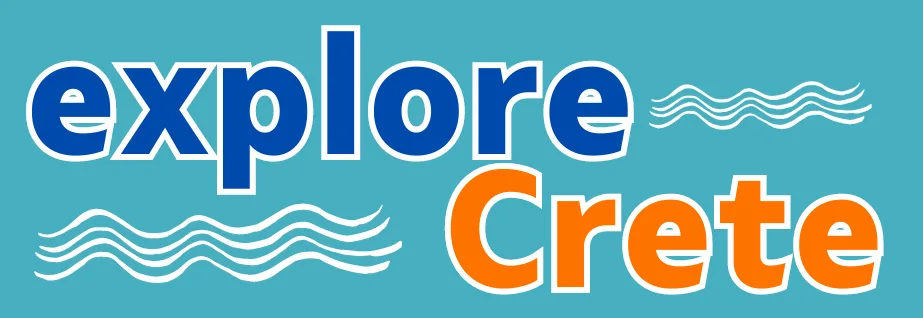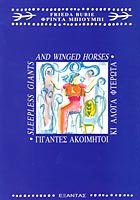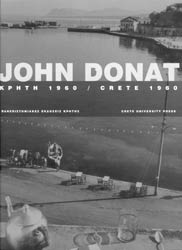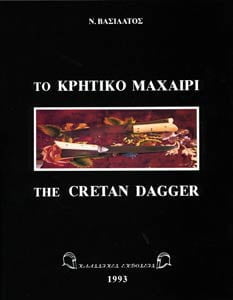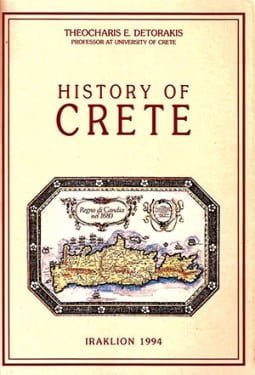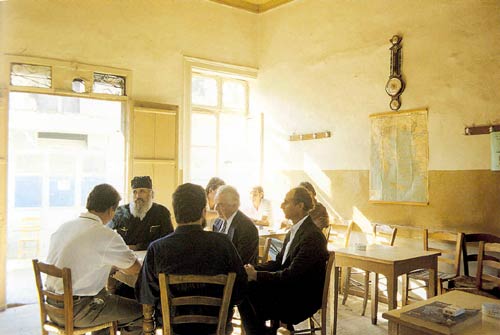I Discover Greece by Harry Franck
Wherein an Incurable Nomad sets forth what befell him and an artist friend during a labyrinthine summer journey through Modern Hellas
Ninety-seven Illustrations from Photographs by the Author and a Frontispiece by His Companion
THE CENTURY CO. NEW YORK LONDON
CHAPTER XXIX, A LONELY JOURNEY TO CRETE
Reviewed by Flavia Radetti
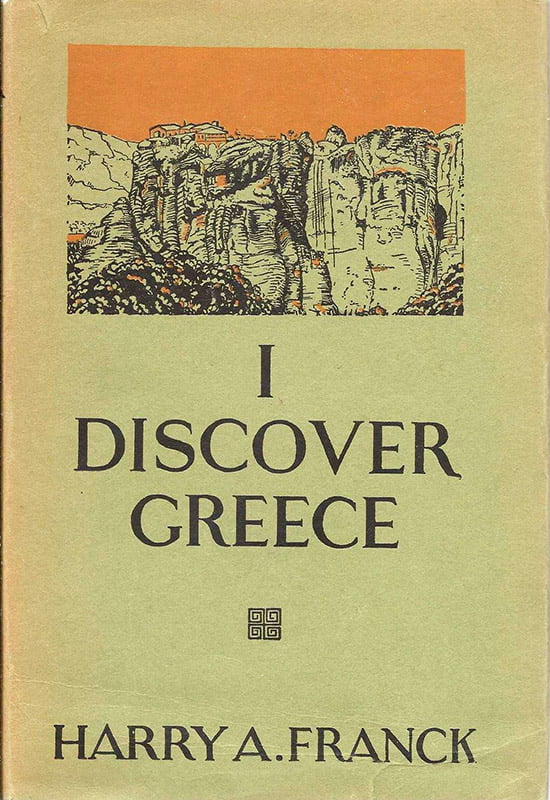
I TOPPED off my Grecian interlude with a moonlight sail to the classic isle of Crete, alone. The artist was moonlighting on the Acropolis, bidding the Parthenon a last sad farewell before sailing on the morrow for the heathery land from which came his ability to economize, sometimes. In the not too early morning I awoke on a deck bench to find our Egypt-bound steamer within sight of Greece’s largest island. The range of barren, almost completely deforested mountains was different from other Greek isles only in that it stretched from horizon to horizon. For Crete is fifty miles long.
Unfortunately, two thirds of its 3326 square miles are sterile rock. The deforesting of past centuries has left it little but bare mountain slopes, down which the rare rains roar quickly into the sea, carrying with them any arable particle of earth they meet on the way. Hence most of the men have gone to the United States or elsewhere, and women and children and the old and the infirm make up much of the population. Yet 350,000 people find a livelihood of some sort on Crete, and thousands of them consider it the nearest approach to an earthly paradise.
About nine we stopped outside a tiny harbor of horseshoe shape, not large enough even for such small steamers as ours. Among the swarms of boatmen who came out to us were two blacks, the first and last Negroes I ever saw in Greece. Once, under the Turks, hundreds of them were brought over from Africa. Canea, second port and capital of Crete, must have been very Turkish before the island was restored to Greece in 1913. There are still several minarets, many graceful old domes, queer old houses in queer old streets, even hubble-bubbles in the cafes. A coffee-house spreads far and wide beneath a huge old plane-tree, from which a chorus of crickets perpetually promises rain; any one who has seen Crete knows they are lying, or at least mistaken. Hot as all Grecian coast towns, was Canea; yet there were patches of snow on the near-by mountain tops, though it was already August.
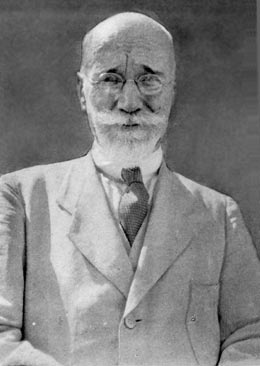
Motor-buses run out early and often to Khalepa, a suburb at the base of Akrotiri Peninsula, long the best residential section; and it cost me precisely two cents to be set down exactly in front of the home of Venizelos. The “Grand Old Man of Greece”-except to the royalists and the partizans, if any are left, of Pangalos-was overseeing the restoration of the home and garden-orchard of his fathers (or fathers-in-law), which he then thought was to serve as his last residence.
Meanwhile the little more than a bungalow in which he lived at the end of the bus line was an astonishingly simple home for so famous a man. Our interview was short; in fact, his first words were the assurance that he would not be interviewed, which spared me the embarrassment of saying that I could not stay long enough for such a formality even were I given to interviewing.
But everything in its place. First, a brief general chat, in English, with the former and future premier’s secretary in a tight little office-studio crammed with many evidences of scholarly tastes. Then the sudden appearance of a man dressed in white, a still hale and hearty gentleman of scanty white hair and snow-white beard, looking very much like a college professor on his vacation, or in retirement. A smiling reply to my first query, (that on the whole he preferred to converse in French rather than in English. A stroll through part of the grounds of the ancestral home, impersonal now in the throes of extensive repairs; a kodak portrait, another for safety’s sake, before an influx of friends and callers, some of them obviously politicians direct from Athens, with important things to fray, or hear, sent me back to the two-cent bus. Besides, my steamer was not to remain long.
Plainly a man with a certain not unjustified sense of his own importance, yet quite as evidently a man well above the Greek average. Eleutherios Venizelos, though his family originally came from Sparta, was born in the little village of Mournies, ten minutes away from where he was planning to end his days. Only the walls of his birthplace remain; but inside them his fellow-islanders, to whom he is still the Grand Cretan, have made a tiny garden, with a commemorative stela in the center, and on the ruined back wall is a white-marble plaque which tells us in golden letters that Venizelos first saw the light of day there in 1864.
His return to his native isle, more than four years before, had aroused great enthusiasm among the undemonstrative Cretans, Every living being in Canea knows and is proud to point out where he lives; nothing to thai prophet in his own country stuff in this case. It had been sixteen years since he lived in Canea, where he wished, so he had recently said, to end his days in the island of his childhood and youth, “far from the noise and false alarms of this world. I want no more to do with the politics of Greece. So many hatreds are still accumulated against me that my re-entrance into the political arena might mean civil war. Henceforth I wish to live in calm and peace, and much as I like Athens, or Paris, I love better my Cretan native land. Nevertheless….” Ah, yes, there is usually a nevertheless in such retirements…”nevertheless, if the Greek people force my hand and oblige me again to take part in politics…”
Though even then half the men in the Zaimis coalition government were “Venizelists,” there was an atmosphere about the end of that Canea bus line which made it no surprise to hear not long afterward that the savior of modern Greece had quitted his isle of Elba and returned to power.
As you should, though you may not, know, this Lycurgus of present-day Greece, educated as a provincial lawyer, was the leader in the revolutionary plots against the Turks who so long prevented the Cretans from politically rejoining their fellow-Greeks. He landed in Athens in 1910, united the Balkans against Turkey, and was the chief single instrument in making the Greece of to-day what it is. He quarreled with King Constantine, the Kaiser’s brother-in-law, and helped to exile him and bring in the armies of the Allies. He matched wits with the keenest political minds of Europe at the Paris Peace Conference, so called, and won for Greece the rich city of Smyrna and the hinterland. But there were plots and counterplots, and in 1920 he fell from power- Then Constantine pushed his armies too far into Anatolia, and when they were overwhelmed by the Kemal-driven Turks, the Venizelos party returned to power under King George and repaired as best it could the disasters others had wrought.
Looking back upon it, I suspect that M. Venizelos, on the day I saw him playing the country gentleman revamping the ancestral estate, had already made up his mind that he must once more lay aside his Thucydides and go back to Athens to do over once more the work he had already twice done. Just why he picked the day following the earthquake disaster of Corinth to overthrow the ministry led and manned by has best political friends, or at least by men to whom he had voluntarily turned over the government, is too complicated a story to interest deeply any one but a specialist in Balkan politics. Not merely Venizelos himself, it seems, believed that those to whom he had handed the reins of state had made a mess of the Liberal party, that the republican regime was in danger of being choked to death, that those in power were sacrificing the country to foreign moneyed interests-mainly another word for Italy.
The Grand Cretan was soon to win an almost unprecedented victory over all opposition groups, a victory which means a turning toward France as against Italy, a victory for the pro-Yugoslavia element over the pro-Mussolini combination, for Venizelos has always been a believer in the Balkans for the Balkan people. It probably means a more favorable attitude toward the free harbor for Yugoslavia at Salonika, perhaps toward that promised the Bulgarians at Kavala or Dedeagatch And to the outside world, to the European powers with whom he has long dealt and who admire and even trust him. as far as one statesman ever trusts another, the return of Venizelos is evidence that Greece is ready at last to settle down and go to work in earnest on her innumerable weighty problems of post-war reconstruction. But since the days of Aristides the Greeks have been notoriously fickle. It remains to be seen whether they will stand behind their greatest modern leader long enough for him to make present-day Greece what it might be.
But though now, at sixty-four, the man who has seen ten revolutions and taken part in eight has entered upon his third period of power, there is little doubt that he would prefer to go back to Crete, with its roses and its asphodels, its wild marguerites and its rhododendrons, its olive orchards and the buried palaces of the kings of Knossos, to his little crowded den and the leisurely study of Thucydides. Yet if republican Greece is to be done with puppet monarchs and opera-bouffe dictators and constant. political turmoil, it must have a stabilizer, and his name is Venizelos. So Thucydides, who has already waited twenty-four centuries, must wait a little longer.
Pangalos I did not see, though he also was living in Crete. It would have taken an hour or two by auto-bus along precipice-bordering roads to reach his residence, perhaps fully as long to get into it, and possibly even longer to get out again; for so at least it has proved to Mr. Pangalos himself. For his residence Is the famous old Izzedine prison, inside an enormous fortress built on the flank of a mountain at the southern end of the Bay of Souda. There he lives in the apartment of the prison director, with a balcony as his share of the outside world, permission to walk twice a day in the big court-garden for exercise, the right to receive books and newspapers. Those privileges may long remain the only freedom of action of a man who for a year ruled Greece with a heavy hand. Most Greeks admit that Pangalos was merely a self-seeker urged on by an ambitious wife; and most of them agree that Venizelos, though he may have made mistakes, is a sincere and honest patriot, of whom there are not too many in the political circles of modern Greece.
The steamer plodded on eastward along the almost perpendicular coast. Rethymno, where we anchored far out, in the hot haze of midday, also has its ancient fortress and several minarets-pointed, unusually high and slender minarets, like sharpened pencils-as against one church tower. A small town, enclosed by an old sea-wall, with a lighthouse at one end, a few greenish fields spreading upward beyond it a little way up the skirts of repulsive mountains rising to a lofty point adorned with the inevitable white chapel, due to be visited on August 15. We loaded bags of caoba and plodded on along the coast.
A stony, mountainous, mostly infertile island, soaring into mountains beautiful at a distance, especially in the purple lights of morning and evening, towns and villages, mainly white, tucked away in the lower laps of them. One mountain piles up in a series of domes which you might fancy the inspiration for the great Constantinople mosques. Here and there stretches of olive-green along- The lower foot-hills, always quickly ending ‘n barren heights not worth terracing. I saw no terraces in Crete, only ash-heaps, sometimes faintly sprinkled, barely prickled, with green, for long distances, without a sign of man or any other animal.
Candia, which the Greeks now call Herakleion, also has. a tiny stone-walled, horseshoe-shaped harbor calked with a lighthouse and a fortress at the respective ends, and big enough for only the tiniest steamers and sailing vessels. The town was less interesting than Canea. Here there was a rage for “improvements,” wide but still unpaved streets, garages in corners of the ancient city wail. The stubs of minarets rose above the rest. On the main street the Greeks had cut down trees from which the Turks were given to hanging them; they were digging up the principal mosque and building something else in its place. The population of Crete used to be fifty-fifty; to-day there is not a Turk on the island.
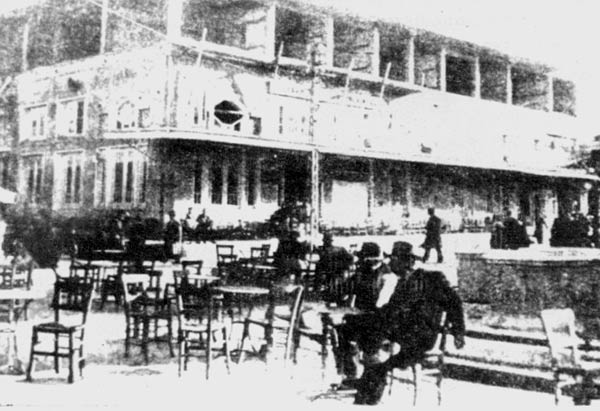
The Hotel Minos, owned by an ex-American and announcing itself, far out beyond the harbor, in “Broadway” electric letters two feet high, is perhaps the best hotel on the Aegean islands, and ranks high among the hostelries of Greece. The proprietor is a modernist; but of what use are bathrooms when there is no running water, because there is no water to run? The youth who pumps what there is may resemble the Minotaur, but even Theseus could not help him, though he might, with Ariadne’s patronage, be useful in guiding one through the labyrinth of Candia’s outer streets.
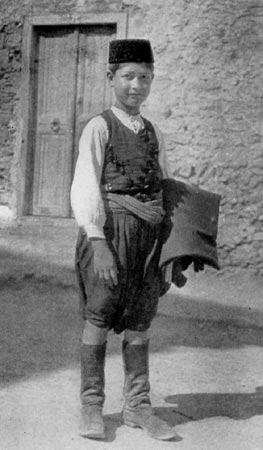
Herakleion has many automobiles but also some bone-twisting closed carriages; there is a little railway, too, but it carries only freight. Here flies bite like hornets-too hot for them in Greece proper? Or perhaps, since Crete is half-way to Egypt, the Egyptian flies summer there. At sunset the whole town turns out and strolls along the beginning of the main road to the interior, past the park in which hundreds sit at cafe tables and outdoor movies and where you have merely to consume rather than pay admission But you must come by nine to be sure of a seat, and wait until nearly eleven before the foolish shadow dramas begin.
Cafe and restaurant tables under white awnings about the old Venetian four-clog stone fountain in the center of town; another farther down the main street toward the harbor. I shall never be surprised to read under a Herakleion dateline that a waiter has been killed in line of duty by an automobile. For the tables cover both sidewalks, not only before the restaurant itself but before the bank building opposite, and waiters carrying food and drink dash back and forth through the traffic descending the street to the little harbor, shouting “Mia peponia!” (which, as I have said before, means a slice of cantaloupe) and that other national war-cry of Greece, “Ma’ista!” meaning “At once!” in the dictionary and “Whenever I get around to it” in practice. Snails were sold in pailfuls now, because during the fifteen fast days of “Little Easter” the pious eat no meat, and snails have no blood.
Some of the million and a half refugee Greeks from Asia Minor and elsewhere have built shack shops in Herakleion, and their makeshift homes are stuck like hornets’ nests against the old city ramparts and other protective structures which spare them the building of a back wall. Moreover, there is a whole new town m the usual bone-dry suburb reached by rattling motor-bus. Out there a dozen cloth-sail windmills, the largest that of a grist-mill with an interesting scene in the stone-lower interior, to which wheat is brought on the hacks of donkeys and other burden-bearers, [he others drawing water, were toiling away in a little depression. The bare streets of the government-built refugee suburb are identical with those elsewhere Women haul up water by hand in the middle of one of them, standing on the stone or mud-brick uncovered well-curb several feet high. Though there are far too many people in Crete for the island to support, the raising of children seems to be the main industry even among the refugees. Between the new settlement and the main town are the finest beaches imaginable, water unsurpassed, where bathing- suits are unnecessary.
The costumes of Crete are a mixture of the old and the modern, the old-fashioned male garb one of the most picturesque ones left in the Near East. The principal cloth is the most delicately blue navy-blue I have ever seen on a man, just a little too blue for even the most showy of us to wear. It is expensive, finely woven of pure wool, many times too thick for my summer taste, and is made-in England. Many are the little open-den tailor shops that turn this cloth into the garb still worn by most countrymen, especially of the older generation, even by boys. The embroidered Jacket . . . Oh, come now, you surely can’t expect me to labor over another costume description this late in the day-see the photographs. It would require an expert-tailor program-writer or a taxidermist or something of the sort to describe adequately the Cretan male costume.
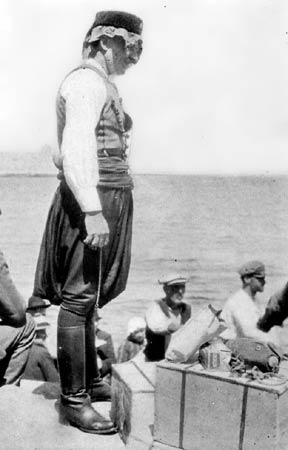
The voluminous trousers serve as a carry-all. Like the kangaroo with its marsupial pouch, the men seem not at all to mind a load like a cow’s heavy udder swinging between their legs. Bread, cheese, olives, anything needed along the way go into and wabble about in the capacious slack of the trousers. The wasp-like waists of the men of Crete have been famous for many centuries, as we shall soon see, and the alzarine or lilac-purple silk sash about the waist costs a lot of money, as money goes in Crete. So do the high boots which malic the Cretan bootblack’s life miserable Most of these are black, well-made riding boots, though not many men ride, boots worthy our proudest army officers. The real swanks wear white sheepskin boots, not only because those are more showy but because, since they are more expensive and less durable and easily soiled, to have them whole and clean is an evidence of wealth. A couple of inches of bare, not always washed, sunburned-as-the-face knees between the high boots and the skirt-trousers seems to be de rigueur among those who pose as he-men. Women also wear the heavy boots, and have their own ideas in dress, but they by no means achieve the circus-parade aspect of the men.
Auto-buses run from Herakleion to various parts of the island. The front seat is tolerable, if you can capture it; but two travelers besides the driver generally crowd into it. The rest of the vehicle is commonly a truck in which passengers sit on the bare floor, or at best on narrow little loose-board seats that have a way of frequently breaking down. But discomfort means nothing to this people.
Personally I preferred to walk. I hate to come home from a trip abroad with my legs already rested; if only one could have the real hardships at the last moment and then fly home … at least it would be a little longer before the call of the open road became imperative again. My tramping shoes had succumbed to Parnassus; my walking clothes and country hat had passed into oblivion. But there is no curing a bad habit. Like the naughty little boy who no sooner gets all dressed up than lie goes out and plays in the mud.
I found myself taking a dusty, sweaty tramp of twenty hot and stony miles, which should at least help to keep me contented during the long sea voyage ahead.
An hour’s walk out the evening-promenade road brought me to Knossos. By (lay the blazing while, soft, glaring limestone of which most of Crete is made powders the grapes and everything else along the edge of the well-traveled highway, and soon gives the pedestrian the appearance of having climbed out of a flour-barrel.
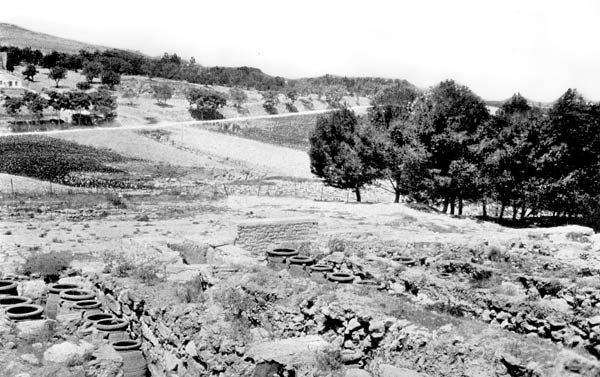
Men, sometimes an immodest woman, jogged by, sitting sidewise on their donkeys, swinging their heavy boots. Two-wheeled one-mule carts rumbled past, each with eighteen pigskins bursting full of new red wine, the drivers asleep. Smaller carts drawn by donkeys reminded one of Ireland.
All are stopped, searched, taxed at the octroi-station on the edge of Herakleion. For to-day, far from exacting from Athens seven brave youths and as many fair maidens yearly as fodder for her bull-headed monster, Crete sends tribute to Athens. Cart-loads, wagon-loads, truck-loads of the splendid big grapes of Crete were just then being shipped from the principal port of Greece’s long island. They came down to the wharves in new baskets with heaped-up woven tops, on all manner of Cretan conveyances, so that the rattle of cart-wheels loose on their axles sounded along the descending main street all night long.
I hardly need remind you that Crete was one of the chief seats of the Mycenaean civilization which nourished before the rise of the Hellenes, reaching its height about fifteen centuries before Christ. Hence for the archaeologist the island is notable mainly for the ruins of ancient Knossos, the traditional capital of Crete, with its remnants of an advanced civilization older than that of Greece. Knossos was entirely modern in its insistence upon hygiene and comfort, on proper drainage, even on daily baths. The palace of its king was famous for its winding stairways, its immense banqueting hall, for a cellar where grain and wine and olive-oil were Stored, so vast that it gave rise to the labyrinth story. To this day it is not clear just what caused the downfall of Knossos. No doubt the savages from the banks of the Danube, who later became the ancient Greeks, having learned many things from the men living behind the high walls of Mycenae Tiryns, Knossos, destroyed this highest form of Aegean civilization as having outlived its usefulness.
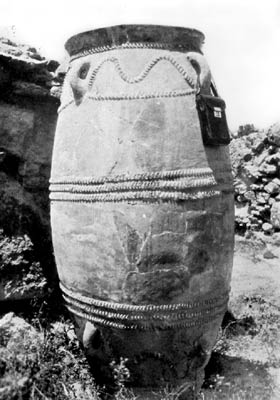
The Knossos ruins lie close to the main road. There are long rows of earthenware jars in stone-faced trenches, many of them big enough to hold a short man standing upright. Others arc scattered about the ruins, the heavier with a dozen or a score of handles. Supplies kept in them? If so the jam had long since been eaten when the archaeologists found them, or the corpses had disintegrated, no contents left; SO the scientists can only guess what purpose they served. They carried the mind back to similar huge jars, hewn out of solid granite, on the plains of Xieng Khuang in French Indochina. Those uncovered at Knossos are of earthenware, yet in a way an even more remarkable feat in the making, so huge are they and so intricate with handles and decorations; and in many cases one marvels no less at the way they have been expertly patched up.
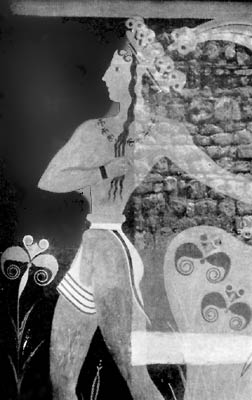
The English archaeologist responsible for the unearthing of Knossos has tried to restore, not without success, enough of its ancient buildings and their decorations to make them tangible to the layman of feeble imagination. The brilliant colors of the restored wall paintings are the most impressive part of this work, to the popular taste; and one would be inclined to credit that Englishman with a gift for exaggeration equal to his self-confidence, were there not in the Candia museum remnants enough of the originals to prove the incredible as to colors, and as to the men’s waists. The slender waists of the men in those strikingly bright restorations of the wall-paintings of ancient Knossos are still, after so many centuries, one of the specialties and chief prides of the male Cretan. They do not seem to use corsets; evidently they are just naturally built that way.
I recommend to the seeker in quest of the picturesque the old aqueduct which strides in huge stone arches across the ravine and the old stone road Just beyond the ruins of Knossos. The modern road, for carts and wagons and panting automobiles, sneaks down through the valley and out again by a long detour, a roundabout shirking of the climb, like most modern roads. The ancient atone one stalks sturdily down through the little river and straight up over the hill beyond, with the directness and scorn for easy going of ancient or primitive peoples.
That old road seems to lead on over the horizon to romance. But it does not, as usual; for I plodded on in the hot, dry sunshine clear over the crest, to a commonplace village, with soldiers and an outdoor lunch-room, then on and on again, without finding any him of romance. Yet something dragged me still farther, hour after hour, for all the heat and dust and, toward the end, feet wearying from the incessant impact with the stony road ; on by a strange trail over a stony ridge to Arkhanes, with its vast fields of flat-topped grape arbors, heavy with ripening fruit, beyond which the Minotaur we call time forbade me to stray. No one in the fields, any more than in the expensively restored ruins of Knossos, during the hot hours of the day; but men and girls were all picking ripening tobacco in the shadows of the hills at sunset.
© explorecrete.com All Rights Reserved. Reproduction or copying without permission is prohibited.
